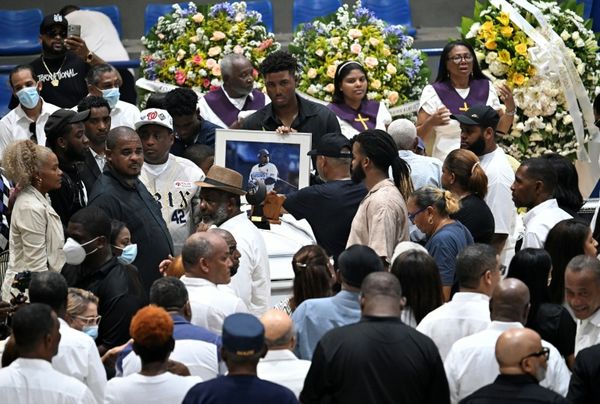
The federal government has given Chicago some pretty good buildings, from the giant Art Deco Old Main Post Office — now enjoying reuse — to the superlative midcentury federal center downtown.
So why would the U.S. General Services Administration now raise a hind leg to this legacy by wrecking the Century and Consumers buildings, two early 20th Century skyscrapers at 202 and 220 S. State Street?
Columnists
In-depth political coverage, sports analysis, entertainment reviews and cultural commentary.
U.S. Sen. Richard Durbin, D-Ill, last month earmarked $52 million for the GSA to demolish the terra-cotta clad towers and two small buildings between them, replacing the ensemble with a safety buffer to protect the Dirksen Federal Building, which is located a block west on Dearborn Street.
The GSA owns the buildings and has been seeking the demolition since 2019, about two years after then-U.S. District Court Chief Judge Ruben Castillo told the Chicago Daily Law Bulletin his concerns that Century and Consumers sat close to the Dirksen’s eastern side.
But is this reason enough send the towers to a landfill — when the federal center is surrounded by buildings and through-streets? The Berghoff Restaurant buildings, 17 W. Adams St., nearly touch the Dirksen’s north edge, but the GSA tells me it has no plans to come after those structures or others.
The feds won’t create a moat around the federal center, but replacing the Century and Consumers with a “secure and landscape[d]” site, as the GSA spokesperson says, is no good either.
The buildings’ demolition would create an economic and pedestrian dead zone on State Street, something neither the street nor the city can afford.
And it would be a shameful waste of some really good Chicago architecture.

Preservation deal taken off the table in 2019
The Century and Consumers buildings seemed headed for reuse in 2017, when then-Mayor Rahm Emanuel approved CA Ventures’ $141 million plan to rehab and redevelop the properties.
Under the effort, the city would have bought the buildings from the GSA and sold them to CA Ventures. The 22-story Consumers Building would become 270 micro-apartments, while the 16-story Century Building would be turned into 159 studio and one-bedroom units.
What a great second act for two historic buildings created by the city’s leading architecture firms. Jenny, Mundie & Jensen designed the Consumers Building, completed in 1913. Holabird & Roche’s Century Building arrived two years later.
See how the city and the federal government were partners, then? In a weird way, they still are. When the GSA decided to demolish the buildings following an FBI security assessment in the wake of Castillo’s stance, Mayor Lori Lightfoot and the city’s Department of Planning and Development affirmed the move in 2019 by snatching back their support for the CA Ventures deal.
“It’s just disappointing, because those are historically-contributing buildings to everything State Street is about,” Chicago Loop Alliance President and CEO Michael Edwards told me.

‘We protect these things. We don’t tear them down.’
At least demolition won’t occur suddenly and under the cover of darkness, like a certain other thing that happened around this time 20 years ago.
And federally-owned buildings are subject to Section 106 of the National Historic Preservation Act, requiring the GSA to “identify and assess the effects its actions may have on historic buildings ... [and] consider public views and concerns about historic preservation issues when making final project decisions.”
Public meetings on the demolition will begin this summer and continue into 2023, the GSA said. Demolition wouldn’t happen until 2024.
So now’s the time for the Lightfoot administration to step up and make some noise. Maybe even get bold enough to landmark the buildings and dare the feds to tear them down.
Meanwhile, the FBI hasn’t publicized its security assessment, so we don't know what dangers to the Dirksen would be prevented by the demolition, or if wrecking the structures was the only solution suggested.
Could adding ballistic glass or eliminating windows from the Dirksen-facing side of the buildings help? We don’t know.
“We wrote a letter [to the mayor’s office] that I think went on to the GSA, saying that for $52 million, you could have [made up] the lost revenue [of not having] any windows on the [Dirksen] side of the building,” Edwards said. “And we’d have the historic Chicago fabric that makes State Street that ‘Great Street.’ We protect these things. We don’t tear them down.”
Following the Sept. 11, 2001 terrorist attacks, the GSA made its buildings open, transparent yet security sensitive.
That’s because cooler, sensible heads prevailed. And they must again now.
Lee Bey is the Chicago Sun-Times architecture critic and a member of the Sun-Times editorial board.
(Editor’s note: This column has been edited to correct the statement that Sen. Tammy Duckworth joined Sen. Dick Durbin in earmarking $52 million to demolish the Century and Consumers buildings. Duckworth was not part of that earmark.)
Send letters to letters@suntimes.com







